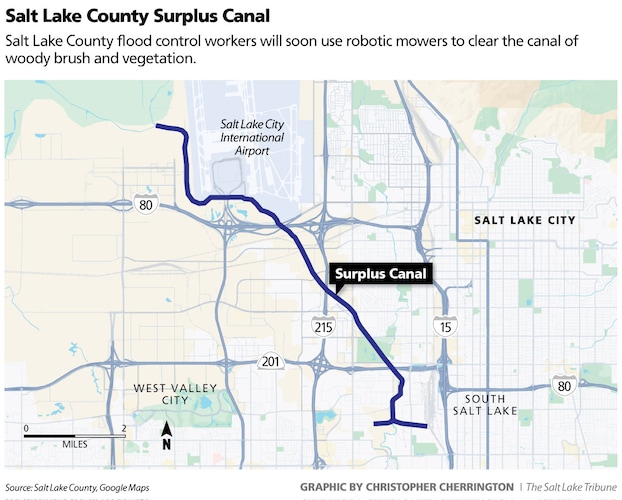A new frontier of flood control is coming to Salt Lake County.
The Salt Lake County Council voted last week to allocate $125,000 for two remote-controlled, robotic mowers, meant to help clear dense, woody brush in spots that are tricky for humans to access.
Coming in at over a ton, the massive remote mowers can cut along slopes as steep as 50 degrees, because they have a low center of gravity and they operate on tracks instead of wheels, county director of Flood Control Engineering Kade Moncur said.
They’ll be working to clear paths along the county’s surplus canal levee system, which stretches from about 2900 South to the Salt Lake City International Airport.
“We were just looking for something that could help us be more efficient,” Moncur said. “It helps accomplish the really large task of basically keeping the weeds down for inspection along the surplus canal levies.”
To maintain the levee system, flood control workers often have to cut through high weeds that can grow as tall as 6-8 feet, Moncur added. Cutting down vegetation that dense takes time, and the flood control department only has 12 full-time employees to maintain the 500 miles of creeks and canals across the county.

(Christopher Cherrington | The Salt Lake Tribune)
Cutting down vegetation is crucial to ensure water can flow freely without getting backed up by weeds and other greenery, because the county’s surplus canal is crucial to controlling any flooding along the Jordan River.
The new mowers can replace a 7-person weed-whacking crew, and each mower will be operated by an employee with a remote control within 300 feet of a given site.
“People are pretty familiar with that type of control, because it’s pretty self intuitive, right? You have two joysticks, you have the controls for the blades and so on,” Moncur said. “… But there are training videos that we would have them go through to make sure, and they always have to do an equipment walk around through the work site.”
With the new machines, flood control’s specialized employees won’t have to take as much time to trim weeds. They can instead refocus on operating heavy machinery during other projects, Moncur said, so the robots won’t be taking human jobs.
Instead, they make human jobs safer, Moncur added, because a worker can now cut down brush without physically being behind the wheel.
“You kind of think they’re like a Tesla of sorts, or like a self-driving car, and I think they’re a little bit scaled back from that,” Moncur said.





